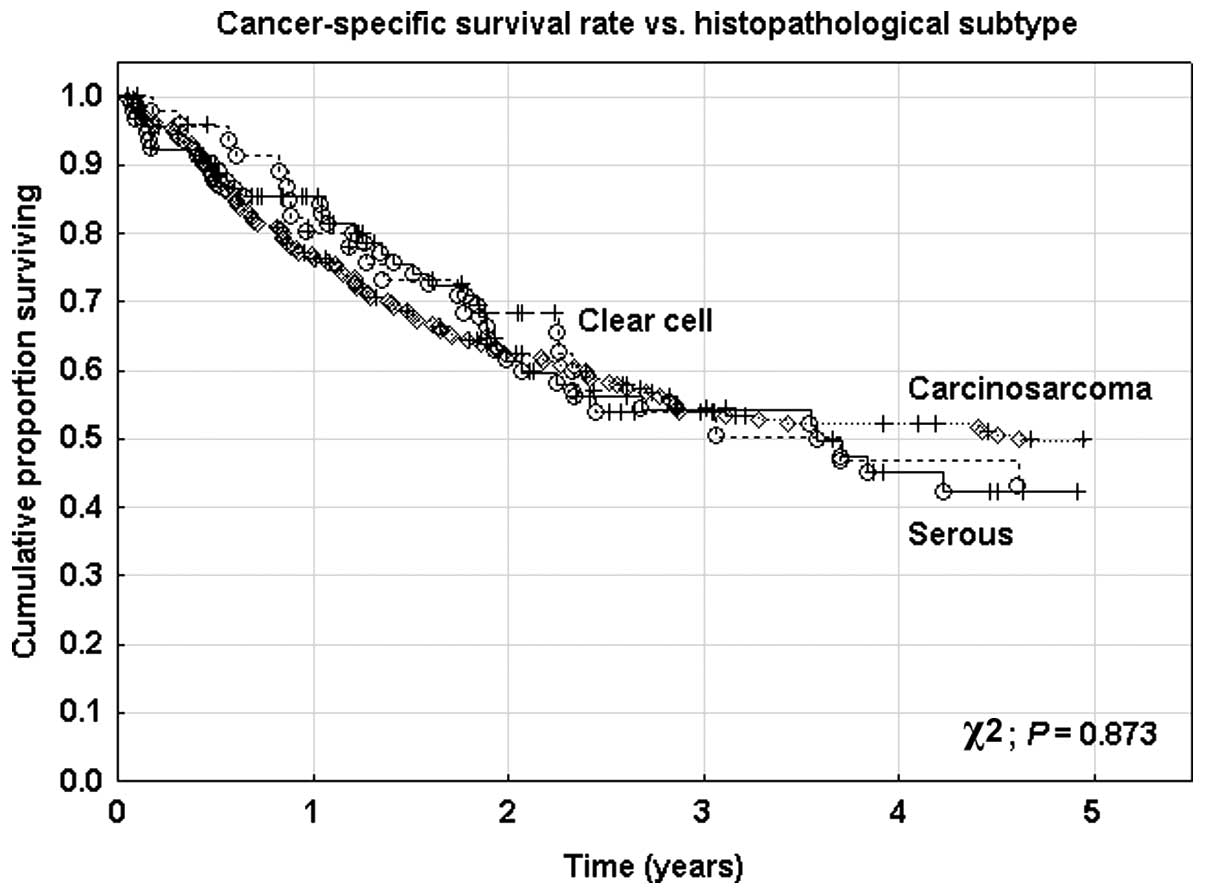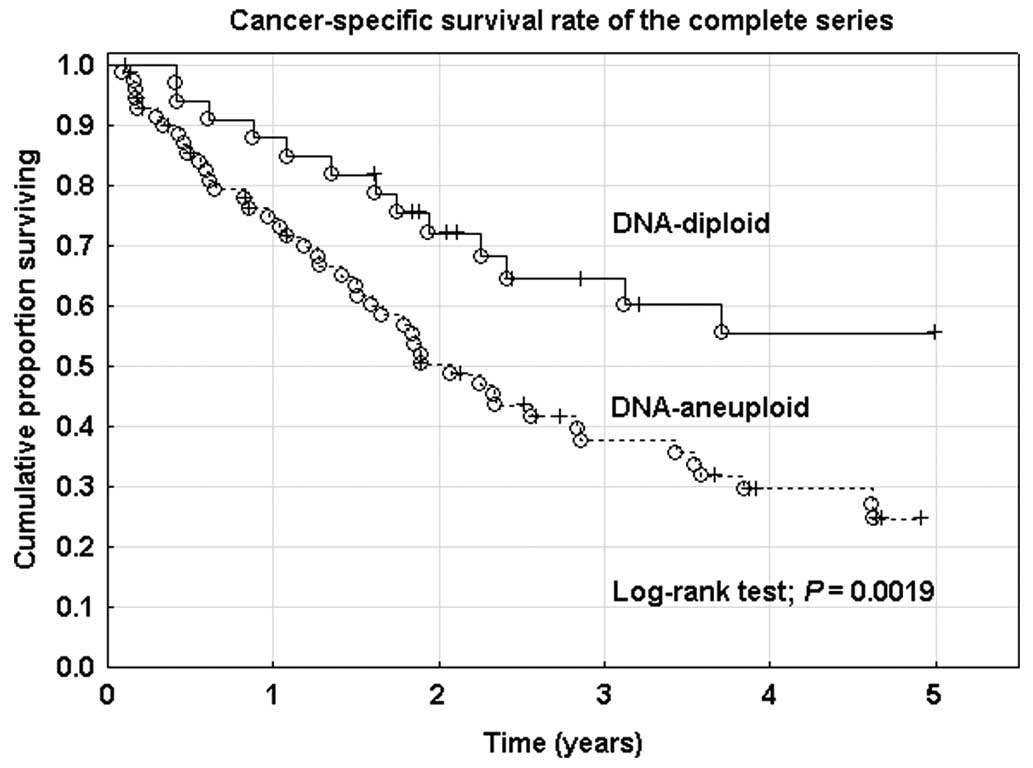|
1
|
Siegel R, Naishadham D and Jemal A: Cancer
statistics, 2012. CA Cancer J Clin. 62:10–29. 2012. View Article : Google Scholar : PubMed/NCBI
|
|
2
|
Setiawan VW, Yang HP, Pike MC, McCann SE,
Yu H, Xiang YB, Wolk A, Wentzensen N, Weiss NS, Webb PM, et al:
Type I and II endometrial cancers: Have they different risk
factors? J Clin Oncol. 31:2607–2618. 2013. View Article : Google Scholar : PubMed/NCBI
|
|
3
|
Hendrickson M, Ross J, Eifel P, Martinez A
and Kempson R: Uterine papillary serous carcinoma: A highly
malignant form of endometrial adenocarcinoma. Am J Surg Pathol.
6:93–108. 1982. View Article : Google Scholar : PubMed/NCBI
|
|
4
|
Hoang LN, McConechy MK, Meng B, McIntyre
JB, Ewanowich C, Gilks Blake C, Huntsman DG, Köbel M and Lee CH:
Targeted mutation analysis of endometrial clear cell carcinoma.
Histopathology. 66:664–674. 2015. View Article : Google Scholar : PubMed/NCBI
|
|
5
|
McCluggage WG: Uterine carcinosarcomas
(malignant mixed Mullerian tumors) are metaplastic carcinomas. Int
J Gynecol Cancer. 12:687–690. 2002. View Article : Google Scholar : PubMed/NCBI
|
|
6
|
Sood BM, Jones J, Gupta S, Khabele D, Guha
C, Runowicz C, Goldberg G, Fields A, Anderson P and Vikram B:
Patterns of failure after the multimodality treatment of uterine
papillary serous carcinoma. Int J Radiat Oncol Biol Phys.
57:208–216. 2003. View Article : Google Scholar : PubMed/NCBI
|
|
7
|
Pradhan M, Abeler VM, Danielsen HE,
Sandstad B, Tropé CG, Kristensen GB and Risberg BÅ: Prognostic
importance of DNA ploidy and DNA index in stage I and II
endometrioid adeno-carcinoma of the endometrium. Ann Oncol.
23:1178–1184. 2012. View Article : Google Scholar : PubMed/NCBI
|
|
8
|
Creasman WT, Odicino F, Maisonneuve P,
Quinn MA, Beller U, Benedet JL, Heintz AP, Ngan HY and Pecorelli S:
Carcinoma of the corpus uteri. FIGO 26th Annual Report on the
Results of Treatment in Gynecological Cancer. Int J Gynaecol
Obstet. 95(Suppl 1): S105–S143. 2006. View Article : Google Scholar : PubMed/NCBI
|
|
9
|
Kosary CL: FIGO stage, histology,
histologic grade, age and race as prognostic factors in determining
survival for cancers of the female gynecological system: An
analysis of 1973–87 SEER cases of cancers of the endometrium,
cervix, ovary, vulva and vagina. Semin Surg Oncol. 10:31–46. 1994.
View Article : Google Scholar : PubMed/NCBI
|
|
10
|
Sorbe B: Predictive and prognostic factors
in definition of risk groups in endometrial carcinoma. ISRN Obstet
Gynecol. 2012:3257902012. View Article : Google Scholar : PubMed/NCBI
|
|
11
|
Creutzberg CL, Van Putten WL, Koper PC,
Lybeert ML, Jobsen JJ, Wárlám-Rodenhuis CC, De Winter KA, Lutgens
LC, van den Bergh AC, van de Steen-Banasik E, et al: Surgery and
postoperative radiotherapy versus surgery alone for patients with
stage-1 endometrial carcinoma: Multicentre randomised trial. PORTEC
study group. Postoperative radiation therapy in endometrial
carcinoma. Lancet. 355:1404–1411. 2000. View Article : Google Scholar : PubMed/NCBI
|
|
12
|
Keys HM, Roberts JA, Brunetto VL, Zaino
RJ, Spirtos NM, Bloss JD, Pearlman A, Maiman MA and Bell JG:
Gynecologic Oncology Group: A phase III trial of surgery with or
without adjunctive external pelvic radiation therapy in
intermediate risk endometrial adenocarcinoma: A gynecologic
oncology group study. Gynecol Oncol. 92:744–751. 2004. View Article : Google Scholar : PubMed/NCBI
|
|
13
|
ASTEC/EN.5 Study Group. Blake P, Swart AM,
Orton J, Kitchener H, Whelan T, Lukka H, Eisenhauer E, Bacon M, Tu
D, et al: Adjuvant external beam radiotherapy in the treatment of
endometrial cancer (MRC ASTEC and NCIC CTG EN. 5 randomised
trials): Pooled trial results, systematic review and meta-analysis.
Lancet. 373:137–146. 2009. View Article : Google Scholar : PubMed/NCBI
|
|
14
|
Nout RA, Smit VT, Putter H,
Jürgenliemk-Schulz IM, Jobseb JJ, Lutgens LC, van der Steen-Banasik
EM, Mens JW, Slot A, Kroese MC, et al: Vaginal brachytherapy versus
pelvic external beam radiotherapy for patients with endometrial
cancer of high-intermediate risk (PORTEC-2): An open-label,
non-inferiority, randomised trial. Lancet. 375:816–823. 2010.
View Article : Google Scholar : PubMed/NCBI
|
|
15
|
Sorbe B, Horvath G, Andersson H, Boman K,
Lundgren C and Pettersson B: External pelvic and vaginal
irradiation versus vaginal irradiation alone as postoperative
therapy in medium-risk endometrial carcinoma-a prospective
randomized study. Int J Radiat Oncol Biol Phys. 82:1249–1255. 2012.
View Article : Google Scholar : PubMed/NCBI
|
|
16
|
Sorbe B, Nordström B, Mäenpää J, Kuhelj J,
Kuhelj D, Okkan S, Delaloye JF and Frankendal B: Intravaginal
brachytherapy in FIGO stage I low-risk endometrial cancer: A
controlled randomized study. Int J Gynecol Cancer. 19:873–878.
2009. View Article : Google Scholar : PubMed/NCBI
|
|
17
|
Aalders J, Abeler V, Kolstad P and Onsrud
M: Postoperative external irradiation and prognostic parameters in
stage I endometrial carcinoma. Clinical and histopathologic study
of 540 patients. Obstet Gynecol. 56:419–427. 1980.PubMed/NCBI
|
|
18
|
Högberg T, Signorelli M, de Oliveira CF,
et al: Sequential adjuvant chemotherapy and radiotherapy in
endometrial cancer-results from two randomized studies. Eur J
Cancer. 36:371–378. 2010.
|
|
19
|
Rutgers JK: Update on pathology, staging
and molecular pathology of endometrial (uterine corpus)
adenocarcinoma. Future Oncol. 11:3207–3218. 2015. View Article : Google Scholar : PubMed/NCBI
|
|
20
|
Pradhan M, Davidson B, Abeler VM,
Danielsen HE, Tropé CG, Kristensen GB and Risberg BÅ: DNA ploidy
may be a prognostic marker in stage I and II serous adenocarcinoma
of the endometrium. Virchows Arch. 461:291–298. 2012. View Article : Google Scholar : PubMed/NCBI
|
|
21
|
Kato DT, Ferry JA, Goodman A, Sullinger J,
Scully RE, Goff BA, Fuller AF Jr and Rice LW: Uterine papillary
serous carcinoma (UPSC): A clinicopathologic study of 30 cases.
Gynecol Oncol. 59:384–389. 1995. View Article : Google Scholar : PubMed/NCBI
|
|
22
|
Garg K, Leitao MM Jr, Wynveen CA, Sica GL,
Shia J, Shi W and Soslow RA: p53 overexpression in morphologically
ambiguous endometrial carcinomas correlates with adverse clinical
outcomes. Mod Pathol. 23:80–92. 2010. View Article : Google Scholar : PubMed/NCBI
|
|
23
|
Sorbe B, Paulsson G, Andersson S and
Steineck G: A population-based series of uterine carcinosarcomas
with long-term follow-up. Acta Oncol. 52:759–766. 2013. View Article : Google Scholar : PubMed/NCBI
|
|
24
|
Strang P, Stenkvist B, Bergström R,
Stendahl U, del Campo Valdes M and Tribukait B: Flow cytometry and
interactive image cytometry in endometrial carcinoma. A comparative
and prognostic study. Anticancer Res. 11:783–788. 1991.PubMed/NCBI
|
|
25
|
Grote HJ, Friedrichs N, Pomjanski N, Guhde
HF, Reich O and Böcking A: Prognostic significance of DNA cytometry
in carcinoma of the uterine cervix FIGO stage IB and II. Anal Cell
Pathol. 23:97–105. 2001. View Article : Google Scholar : PubMed/NCBI
|
|
26
|
Danque PO, Chen HB, Patil J, Jagirdar J,
Orsatti G and Paronetto F: Image analysis versus flow cytometry for
DNA ploidy quantitation of solid tumors: A comparison of six
methods of sample preparation. Mod Pathol. 6:270–275.
1993.PubMed/NCBI
|
|
27
|
Huang Q, Yu C, Zhang X and Goyal RK:
Comparison of DNA histograms by standard flow cytometry and image
cytometry on sections in Barrett´s adenocarcinoma. BMC Clin Pathol.
8:52008. View Article : Google Scholar : PubMed/NCBI
|
|
28
|
Goff BA, Kato D, Schmidt RA, Ek M, Ferry
JA, Muntz HG, Cain JM, Tamimi HK, Figge DC and Greer BE: Uterine
papillary serous carcinoma: Patterns of metastatic spread. Gynecol
Oncol. 54:264–268. 1994. View Article : Google Scholar : PubMed/NCBI
|
|
29
|
Salvesen HB, Iversen OE and Akslen LA:
Prognostic significance of angiogenesis and Ki-67, p53 and p21
expression: A population-based endometrial carcinoma study. J Clin
Oncol. 17:1382–1390. 1999.PubMed/NCBI
|
|
30
|
Alkushi A, Lim P, Quino-Parsons C and
Gilks CB: Markers of proliferative activity are predictors of
patient outcome for low-grade endometrioid adenocarcinoma but not
papillary serous carcinoma of endometrium. Mod Pathol. 15:365–371.
2002. View Article : Google Scholar : PubMed/NCBI
|
|
31
|
Alkushi A, Kobel M, Kalloger SE and Gilks
CB: High-grade endometrial carcinoma: Serous and grade 3
endometrioid carcinomas have different immunophenotypes and
outcomes. Int J Gynecol Pathol. 29:343–350. 2010. View Article : Google Scholar : PubMed/NCBI
|
















